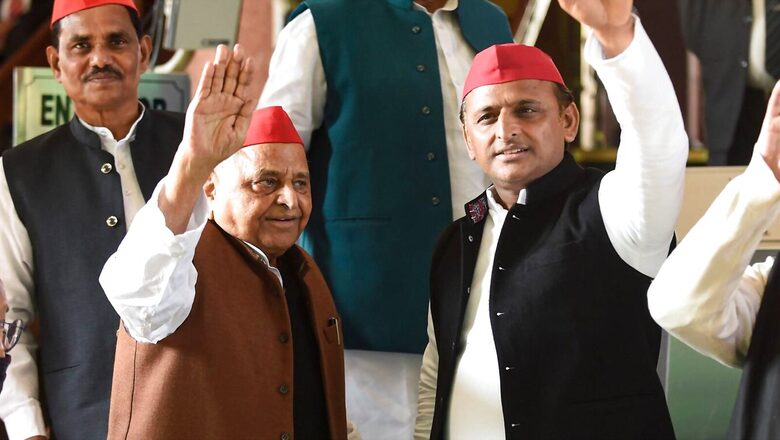
views
As Uttar Pradesh elections 2022 approach, one of the seats in the spotlight is Azamgarh. The seat, for long, has been considered a Samajwadi Party bastion, but that is no longer the case. A look at the result trends since the 2009 Lok Sabha elections shows BJP and BSP having made significant gains in Azamgarh.
In fact, the BJP had won the Azamgarh seat in 2009 by fielding a Yadav face who was earlier a winning candidate for both the SP and BSP. When Ramakant Yadav won the seat in 1996 and 1999, he was a Samajwadi Party candidate. He contested and won the seat for the BSP in 2004. Yadav switched to the BJP in 2009 and again won the seat, bagging 35.13% votes, while the BSP and SP won 28.18% and 17.17%, respectively.
In 2014, when SP patriarch Mulayam Singh Yadav won the seat, he secured 35.43% votes, followed by BJP’s Ramakant Yadav who won 28.85% votes. BSP candidate Shah Alam won 27.75% votes. In 2019, Akhilesh Yadav fought under the SP-BSP alliance, he got 60.36% votes, followed by BJP’s Dinesh Lal Yadav Nirahua with 35.12% votes.
The outcome of the last three Lok Sabha elections and the vote share of the parties in each election indicate it’s anyone’s game in Azamgarh this time. The SP and BSP, in fact, saw their vote share coming down in the 2019 elections by around 3%, while the BJP saw its vote share increase by around 6%.
Demographically, the Azamgarh district has around 84% Hindus and 16% Muslims. As per the 2019 election data, the Azamgarh Lok Sabha constituency had around 17 lakh registered voters — upper castes (17%), Dalits (25%), OBCs (40%) and Muslims (18%). Among the OBCs, around 21% are estimated to be non-Yadavs. Yadavs and Muslims, thus, with a combined voter strength of 37% emerge as kingmakers.
It is said that Azamgarh has so far resisted the saffron tide, be it the 2014 win of Mulayam Singh Yadav fighting the Narendra Modi wave or the BJP not being able to win any Assembly seat here in 2017 despite nearly stamping out the Opposition in the rest of the state. But it would be premature to write off the ruling party in Azamgarh.
Decoding Azamgarh
The Azamgarh Lok Sabha constituency comprises five Assembly segments — Gopalpur, Azamgarh, Sagri, Mehnagar and Mubarakpur. It was speculated earlier that SP chief Akhilesh Yadav could contest from Gopalpur since he is the sitting MP from Azamgarh. But the SP has now announced Akhilesh’s candidature from Karhal seat in Mainpuri district, considered to be another SP stronghold.
As per local journalists, Gopalpur has around 30% OBC voters, 28% upper castes, 24% Dalits and 14% Muslims. In numbers, Yadavs are the largest voting bloc in the constituency, making up around 19% of the total voter strength. Together with Muslims, they make around 33%.
Consider a scenario in which the constituency sees consolidation among 67% non-Yadav-Muslim voters. Discounting Jatav numbers, who traditionally back Mayawati’s BSP, the BJP would be in a winning position.
Since 1996, the Gopalpur Assembly constituency has seen the SP and BSP getting top two positions. That changed in 2017 when SP’s Nafeesh Ahmad won the seat securing 37.80% votes, but the BJP emerged as runner-up securing 29.83% votes. The BSP ranked third with 28.90% votes. This was a far cry from 2012 when the BJP had managed only 6.79% votes here.
The BJP won the Azamgarh Lok Sabha seat in 2009 but the Hindu vote consolidation began in its favour after the 2013 Muzaffarnagar riots, a voting trend reflected in elections since 2014.
Can BSP End Up Helping BJP?
In 2019, the SP and BSP fought the General Elections in an alliance, but have parted ways this time. While Akhilesh Yadav has been active in his campaign, BSP chief Mayawati, the vote puller and architect of the once successful Dalit-Brahmin-Muslim combine, is largely missing in action.
Most opinion polls have also given her party only around a dozen seats in the 403-seat Assembly. That means around 25-30% votes the BSP got in the past elections are up for grabs, and the BJP, with a non-Jatav voter campaign as its base, can benefit.
The impact is expected to be more pronounced in eastern Uttar Pradesh with the construction of the Ram Temple beginning in Ayodhya and the inauguration of the Kashi Vishwanath Dham Corridor in Varanasi.
The Owaisi Factor
It would be a folly to dismiss Asaduddin Owaisi’s AIMIM in the upcoming UP polls based on its poor performance in last year’s West Bengal Assembly elections. Many analysts had virtually written off the AIMIM for Bihar elections as well, but the party put up a promising performance, winning five seats in Muslim-dominated Seemanchal area.
Owaisi can throw surprises in Uttar Pradesh, too, if his party can align some of the Muslims votes. That would dent the SP’s chances, but the prospect is unlikely to bother Owaisi who has been a bitter critic of Akhilesh Yadav. The AIMIM leader has publicly appealed to the Muslims in UP not to vote for the SP in a state where Muslims form around one-fifth of the state’s population. Owaisi has also made Azamgarh, with 16% Muslim population, a key focus area of his UP campaign.
Read all the Latest Politics News here




















Comments
0 comment